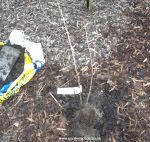Categories
Calendars
Guides
Reviews
Archive
Gallery
Articles
Ask Our Gardening Expert
Growing Blackcurra
Planting
Blackcurrants Dig the soil
to a spade's depth a couple of month's before planting - this will allow
the soil to settle. Add as much well-rotted compost as is available and
dig it in well. Where compost is not available, add a good handful or so
per square metre (yard) of bonemeal or any other long lasting fertiliser. The best time to plant blackcurrant bushes is early winter,
mid-November
time is good. They can however be planted any time up to
mid-March
as long as the
soil is not water-logged or frozen. The plants should be spaced
about 1.8m (6ft) apart. Dig a hole wide enough to take the roots without cramping them.
To encourage this growth, plant the
bushes roughly 5cm (2in) deeper than they were in the pot or at the
nursery if bare-rooted. Fill around the roots with soil and firm it down
with your foot. When
planted, trim every shoot to within two buds above soil level. This may
sound drastic, because it will result in the plant only being about 5cm
(2in) high. However, it will encourage a strong root system as well as
sturdy growth above ground. Care
of Blackcurrants An annual mulch of garden compost will make
easy work of both if available. Where you have no garden compost,
covering the surrounding soil with a weed control fabric will do exactly
the same job and will last for many years.
Click here to buy your weed
control fabric online. A good two handfuls of bonemeal in spring spread around each plant will
also do a whole lot of good. Do not prune the plants in the first winter after planting. In the second
and subsequent winters, prune to encourage new growth. Firstly, remove
any stems which are damaged, diseased or crossing each other. Then, trim
away 20% of the central part of the plant to leave the centre more
open. Finally, remove about 15% of the remaining old wood.
Blackcurrant bushes are available in pots or bare-rooted from garden centres or come
bare-rooted through the post. The
depth of planting is quite important with blackberries. The bushes
naturally produces a large number of stems from just below ground level
(unlike red and white currants).
The
depth of planting is quite important with blackberries. The bushes
naturally produces a large number of stems from just below ground level
(unlike red and white currants).
Watering, weed prevention and pruning are the key requirements for
blackcurrants. They will appreciate watering when conditions are dry and
especially when the fruits are forming. Keep the weeds at bay to prevent
competition for moisture.
Name: jim@GardenAction
E-mail: Private
Date posted: November 21, 2011 - 09:23 pm
Message: I disagree. Cut shoots down to an inch above the soil. New shoots grow next year that should fruit the following year. Next year, prune back the weakest and let the others produce their fruit.
Name: Brian
E-mail: Private
Date posted: November 21, 2011 - 01:51 pm
Message: New blackcurrant bushes planted. Info from firm says do not prune until next year.This does not sound correct. Should I prune all shoots now please
Name: Cos
E-mail: Private
Date posted: July 01, 2011 - 08:43 am
Message: Hi,
I am interesting too, in buying red,white , and black currents for my farm, central europe.
could you advise from Where could I order it at discount price?
Name: Ruthanne
E-mail: Private
Date posted: November 05, 2010 - 11:12 am
Message: I have had a very healthy, luxuriant black currant bush for 6 years. It blooms every spring but alas, no fruit ever sets. In another part of the property, I have a red currant bush (only 3 years old) that bears fruit every year. Both bushes have similar light and soil. What can I do for the black currant so that it produces fruit?
Name: Charles
E-mail: Private
Date posted: October 04, 2010 - 12:32 pm
Message: I am interesting in buying red,white , and black currents for my farm in Southern PA.
From Where could I order it at discount price?